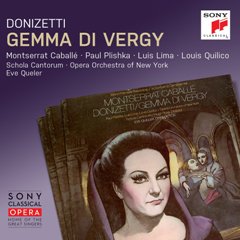Gaetano Donizetti - Gemma di Vergy (1976/2017)
Gaetano Donizetti - Gemma di Vergy (1976/2017)

Disk 1 1.Sinfonia 2.Act I : Scene 1 - Qual guerriero su bruno destriero 3.Scene 2 - Questo sacro augusto stemma 4.Scene 2 - Nella stanza, che romita al dolor dischiude il cielo, languira quest'avvilita 5.Scene 2 - Una preghiera unanime per Gemma 6.Scene 2 - Mi toglieste a un sole ardente 7.Scene 2 - Lascia, Guido, ch'io possa vendicare l'oltraggio 8.Scene 3 - Nuove contese?... Oh cielo! Un ferro sguainato! 9.Scene 3 - Una voce al cor d'intorno 10.Scene 3 - Nessun sogno a te predisse ch'oggi torna il tuo Signore? 11.Scene 3 - Egli riede? oh lieto istante! 12.Scene 3 - Ite - festeggi ognuno del mio sposo l'arrivo! 13.Scene 3 - O vergogna! me infelice! 14.Scene 3 - Dio possente! tu nol sai quanto amai lo sconoscente! 15.Scene 3 - E il Conte? Il mio consorte? - Dei scordarlo 16.Scene 3 - Perche il Conte scacciami? Perche? 17.Scene 4 - Dritto al segno vibrasti, io l'ho ferito la dov'ei mi colpi 18.Scene 5 - Lode al forte guerriero 19.Scene 6 - Qui un pugnale! Chi 'l confisse a segnal di ria vendetta? 20.Scene 6 - Ah! nel cuor mi suona un grido 21.Scene 7 - Guido! Io tremo!... Questo sangue? Dimmi, Gemma e morta? 22.Scene 7 - Un fatal presentimento in quel sangue io veggo iscritto 23.Scene 8 - Assassino, che il ferro immergesti 24.Scene 9 - S'avanzi il reo infido Saraceno 25.Scene 9 - Tigre uscito dai deserti 26.Scene 9 - Sia quel reo sospeso al laccio 27.Scene 10 - Un suo sguardo, ed un suo detto questo braccio disarmo 28.Scene 10 - Mio signor, non piu mio sposo: se la morte a me giurasti, una vittima ti basti 29.Scene 10 - Di' ch'io vada in Palestina 30.Scene 10 - Basta, o Gemma... ah! ch'io non posso... Parla... dimmi... Sei commosso? 31.Scene 10 - Fui tradita, ah disleale! Disk 2 1.Act II : Scene 1 - Mi suonan pianto cosi mesti accenti 2.Scene 2 - Congiunti, cavalier, qui senza fasto all'imeneo novello testimoni vi chiesi 3.Scene 3 - Ecco il pegno ch'io le porsi! 4.Scene 3 - Ti renda il ciel propizio padre di cara prole 5.Scene 3 - Questa soave immagine calma i miei spirti 6.Scene 4 - Vieni, o bella 7.Scene 4 - A voi grata pur son, dilette amiche 8.Scene 5 - D'Arles tu piu non rammenti 9.Scene 6 - E dessa in mio potere, e in questa mano e morte 10.Scene 6 - Odi me, iniquo 11.Scene 7 - Quella man che disarmasti ti die' vita, o schiavo ingrato 12.Scene 9 - Tutto tace d'intorno 13.Scene 10 - Non e ver, non e quel tempio schiuso a rito nuziale 14.Scene 10 - Qual consigio! - Un solo! - E quale? 15.Scene 11 - Eccomi sola alfine 16.Scene 11 - Da quel tempio fuggite, angioli tutti 17.Scene 11 - Ecco, tutto e finito 18.Scene 11 - Un altare ed una benda fian mia cura insino a morte 19.Scene 11 - O giusto Dio! che sento? Suono di pianto a me trasporta il vento 20.Scene 13 - Ah! Chi mi accusa, chi mi grida moglie infame, parricida? Gemma - Montserrat Caballé Ida - Natalya Chudy Tamas - Luis Lima Conte di Vergy - Louis Quilico Guido - Paul Plishka Rolando – Mark Munkittrick Schola Cantorum New York Opera Orchestra Eve Queler – conductor
The opera Gemma di Vergy was written to showcase the incredible voice of Giuseppina Ronzi. The sopranos Ronzi and Malibran had a going feud in those days, in which each competed for the affections and adulation of the opera going public. Bellini and Donizetti helped fuel the rivalry by showcasing their voices: Malibran was Bellini's favored prima donna, and Donizetti composed music to suit the talents and vocal prowess of Ronzi. Gemma is a character out of sixteenth-century French history and legend. She is the central figure in a highly melodramatic plot, in which she gets rejected and her husband murdered. The music Donizetti wrote for her is difficult in the extreme, both in its demand on the vocalist's technical virtuosity, and in its demands on her emotional stamina. She is the main character throughout the story, and the opera's success both musically and dramatically relies on the successful portrayal of her character alone.
"Mi toglieste a un sole ardente," for the tenor voice of Tamas in the opera, became one of those numbers which aroused political demonstrations on the part of Italian opera goers. In later years it was used as a popular concert piece by vocalists. In the 1830s, Donizetti became interested in expanding the dramatic vocabulary of formal operatic conventions of early nineteenth-century opera. He was frustrated by the many conventions handed down to composers and singers from eighteenth-century practices, which audiences expected in their operas, but which were often anti-dramatic. One of these conventions was the mid-opera finale. Here he alters the construction to help build the intensity of the ending. His Act I finale is built of two large and intense slower units, which climax in a furious stretta for Gemma.
The opera premiered on December 26, 1834, opening the winter carnivale season of Milan's La Scala theater. It was a successful opera as long as there were sopranos who could sing the difficult role, and enjoyed a great deal of popularity with audiences almost until the end of the century. But although there is much beautiful music in Gemma di Vergy, there are obvious weaknesses also. The plot is lame, and none of the characters really elicit human sympathy. The libretto was written by Giovanni Emanuele Bidera after a play by Alexandre Dumas. ---Rita Laurance, allmusic.com
download (mp3 @320 kbs):
yandex 4shared mega mediafire uloz.to cloudmailru








